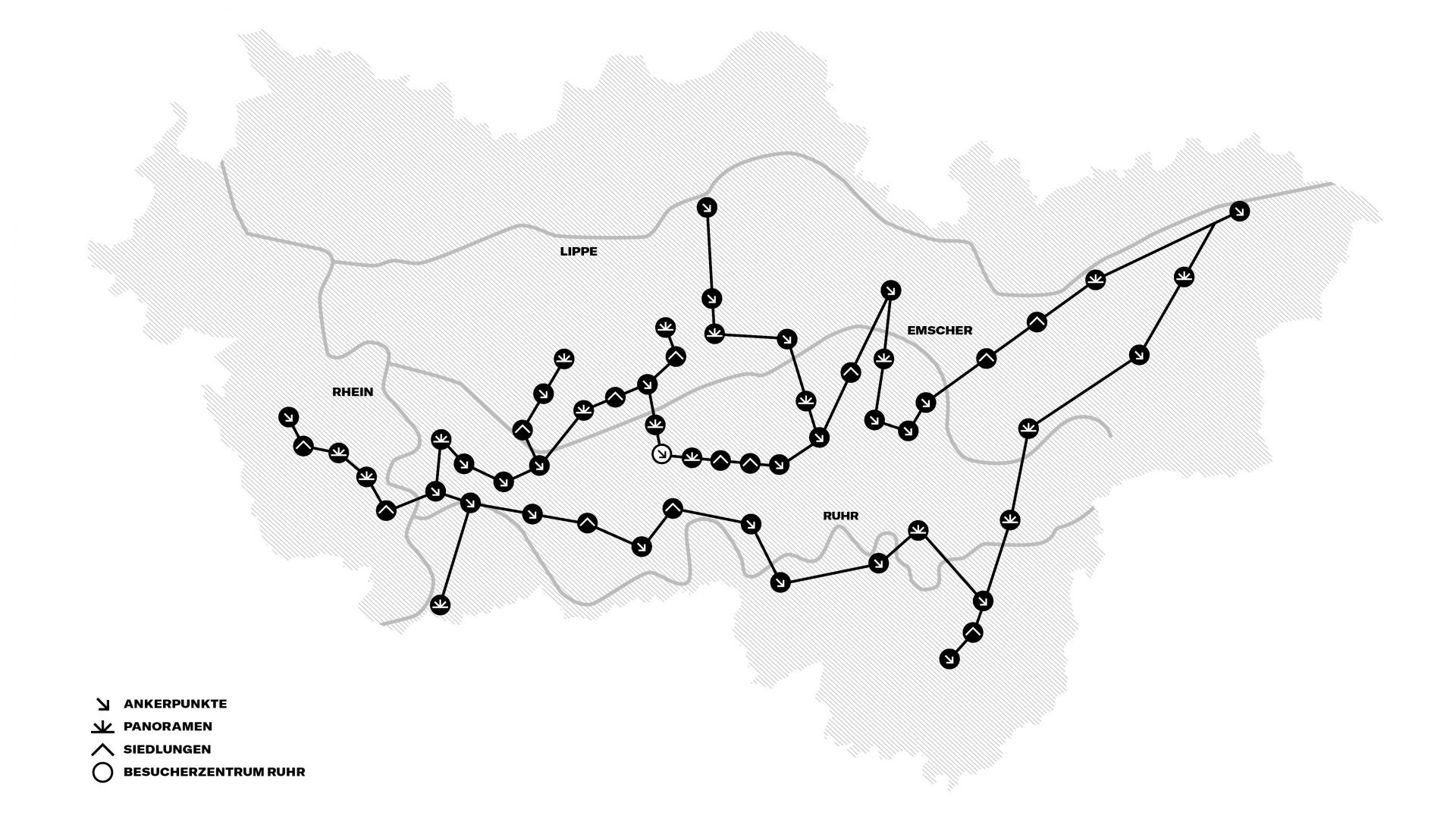The Industrial heritage route...
... connects the most important and touristically most attractive industrial monuments in the Ruhr area as a tourist themed route. The network of the route includes 27 anchor points, locations with special historical significance and outstanding tourist attractiveness. The Industrial Heritage Route also includes 17 viewpoints, 13 settlements and numerous themed routes.
Over a distance of 400 kilometers, the “Industrial Culture Route” invites you to take a tour of discovery, where you can view all the important evidence of the Ruhr area’s 150-year industrial past. This provides visitors with a unique heritage of the Ruhr metropolis to explore, including the Ruhr area's only UNESCO World Heritage Site, Zollverein in Essen, and 27 anchor points where industrial history and structural change can be experienced. In addition, 17 impressive panoramas and 13 settlements offer an insight into the lives of people in the shadow of the winding tower and blast furnace.
Coal and steel form the basis of what once made the Ruhr area one of the world's leading mining regions. However, the related themes of energy, transport, chemicals and water also come to life along the route thanks to a variety of industrial heritage offerings. These include various themed routes, such as to the former workers' settlements, which cover a total of more than a thousand locations.
Brown signs with white lettering show you the way along the industrial heritage route. At each anchor point, the highlights of the route, a yellow signal object marks the location. At all locations related to the route you will find at least three signposts: one that contains information about the route, one that places the location in the themed route, and one that gives information about the location itself. Most of the other locations along the route also have simpler plaques about the history and local importance.
57 outstanding testimonies of the industrial past and present of the Ruhr area form the route of industrial culture. These include nationally important industrial plants as well as well-known worker colonies, museums and vantage points. Together with the more than 1.000 locations of the 31 themed routes, the main locations of the route - anchor points, panoramas and settlements - open up the industrial cultural landscape of the Ruhr area in a unique way.
Mines, smelting works, tailings dumps, colonies, vantage points: where people once worked hard and labored, today visitors can explore vibrant industrial heritage sites with tourist appeal and enormous historical significance. The 57 main locations of the route, the primary locations, stand for successful structural change in the Ruhr area.
Clicking on the map takes you to the respective subpage of a location.
The route of industrial culture includes 27 historic locations with special historical significance. They are the industrial monuments most attractive to tourists in the Ruhr area and therefore the anchor points of the route. Here, visitors can experience industrial culture and the history of the Ruhr area directly and impressively.
The 17 panoramas and vantage points of the Route of Industrial Culture guarantee special insights and fascinating views of one of the largest metropolitan areas in Europe. The former industrial wastelands, monuments and towers often allow all-round views of the region. As the "artificial summit" of the Ruhr area, the heaps combine the areas of recreation, art and history. And where the overburden of mines and smelters was once dumped, people and nature have long since reclaimed the land and new forms of leisure activities have established themselves.
The Industrial Culture Route honors the 13 most significant and beautiful settlements in the Ruhr Metropolis. Because the burgeoning industrial age has not only caused the number of workers to skyrocket, but also the need for living space. Mass housing for the workers led to extensive settlement construction. The term "life in the colony" therefore became a synonym for "life in the Ruhr area". Factory settlements and colliery colonies should do one thing above all: bind the workers to their own company. When the dying mines also heralded the end of many settlements, people even took to the streets for their colony and their homeland.
Industrial heritage route – explanatory film
What is the Industrial Heritage Route? This short film explains the background of the "Route Industrial Culture" and what the Regionalverband Ruhr has to do with it.
You can find more videos about the Route of Industrial Heritage HERE in our YouTube playlist.

Orientation at the locations
SIGNAL OBJECTS
Bright yellow and unmistakable: the so-called signal objects mark each of the 27 anchor points of the industrial heritage like oversized pins - and thus make the industrial heritage visible from afar.

Orientation at the locations
SLABS
At each primary location - i.e. the anchor points, panoramas and settlements - there are at least three slabs with explanatory texts on the industrial heritage route, on the classification of the location in the themed route(s) and on the location itself.

Orientation at the locations
NOTICE BOARDS
Information boards such as this one for the Zollverein pit 3/7/10 provide detailed information on site about all locations along the Industrial Heritage Route. Here visitors can find information about the history or special details of the site.
